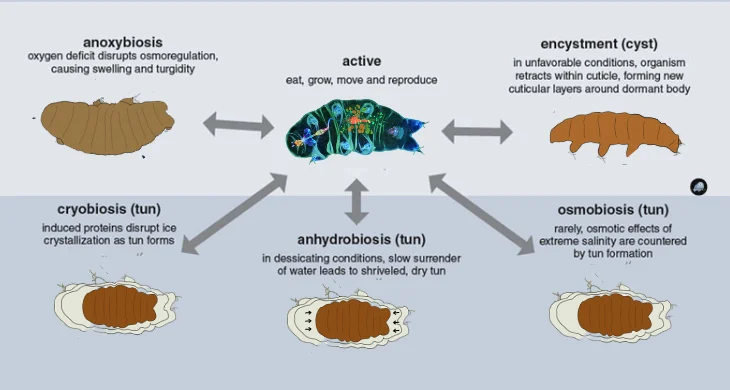Explore the extraordinary world of tardigrade proteins and their surprising influence on defying aging and preventing diseases in humans. Discover the groundbreaking research unraveling their unique molecular pathways and the transformative impact they hold for medical science and longevity.
Introduction to Tardigrade Proteins
Tardigrades, also known as water bears, defy the odds with their exceptional resilience against extreme conditions. Yet, their microscopic size belies a profound secret: proteins within these tiny creatures hold unforeseen potential for human health. This section delves into the awe-inspiring world of tardigrade proteins, shedding light on their remarkable ability to endure desiccation, radiation, and more. As we embark on this exploration, we uncover how these proteins, once thought limited to tardigrades, might just hold the key to defying aging and preventing diseases in the realm of human health.
Resilience Genes
In this section, we delve into the genetic underpinnings that empower tardigrades to endure harsh environments. Unravel the intricate network of resilience genes that enable these extremophiles to survive desiccation, extreme temperatures, and even the vacuum of space. By exploring the unique mechanisms these genes trigger, we gain insights into the molecular pathways that underlie their unparalleled endurance. As we uncover these survival secrets, we begin to appreciate the potential of these genetic adaptations to inform strategies for human health, offering new perspectives on combating aging and diseases.
Damage Suppressor Proteins
In this segment, we delve into the remarkable role played by specific tardigrade proteins known as damage suppressors. These proteins act as vigilant guardians, shielding cellular structures and vital biomolecules from harm during times of stress. Discover the intricate mechanisms through which these proteins intervene to prevent damage accumulation and maintain cellular integrity. By understanding how damage suppressor proteins operate, we uncover the potential insights they offer into enhancing human cellular protection, reducing the impact of stress-induced damage, and potentially mitigating the effects of aging and diseases.
Parallels to Human Health
This section unveils the intriguing parallels between the resilience mechanisms of tardigrade proteins and the challenges posed by aging and age-related diseases in humans. Explore how the protective strategies employed by these proteins resonate with our quest to mitigate cellular damage and preserve function over time. By examining the shared molecular pathways, we gain insights into potential strategies for enhancing human health, offering new perspectives on longevity and disease prevention. This alignment between nature’s resilience and human health aspirations serves as a foundation for innovative approaches in medical research.
Molecular Pathways
Venture into the microscopic realm of molecular pathways that orchestrate the operation of tardigrade proteins. Uncover the intricacies of how these proteins interact with cellular structures, trigger signaling cascades, and initiate protective responses. By dissecting these pathways, we gain valuable insights into mechanisms that can bolster human cellular protection. Delve into the interplay of proteins, enzymes, and cellular machinery that underpin the remarkable resilience of tardigrades. As we decipher these pathways, we uncover potential avenues to enhance our understanding of cellular stress responses and to develop innovative strategies for combating aging and disease in humans.
Regenerative Medicine and Protein Engineering
This segment delves into the frontiers of scientific exploration, where knowledge of tardigrade proteins holds promising implications for regenerative medicine and genetic modification. Discover how researchers are harnessing these proteins’ remarkable properties to enhance cellular resilience and repair processes. Uncover ongoing studies that aim to translate tardigrade protein insights into innovative therapies, paving the way for regenerating damaged tissues and modifying genes for improved health outcomes. As the intersection of biology and technology advances, the potential to leverage these proteins for medical breakthroughs becomes increasingly tangible, offering new horizons in healthcare and well-being.
Nature’s Adaptations
In this contemplative section, we pause to marvel at the journey that unfolds from humble microscopic organisms to the threshold of potential medical revolutions. Reflect on the power of nature’s adaptations, where the resilience of tardigrade proteins transcends their diminutive size, inspiring innovative solutions in regenerative medicine and genetic modification. Witness the capacity of nature’s creations to pave the way for groundbreaking discoveries that may reshape human health. As we gaze at these tiny organisms, we recognize that their adaptations hold the key to unlocking doors of healing, underscoring the boundless potential hidden within nature’s intricacies.
FAQ’s
1. What are tardigrade proteins?
Tardigrade proteins are molecules found in these microscopic extremophiles, known for their remarkable resilience to extreme conditions.
2. How do tardigrade proteins contribute to human health?
Recent research suggests that certain tardigrade proteins may hold insights into combating aging and age-related diseases in humans.
3. What is the significance of tardigrade proteins’ resilience genes?
Tardigrade proteins’ resilience genes offer clues about cellular protection mechanisms that may be applied to human health and longevity.
4. Can tardigrade proteins prevent damage in human cells?
Certain tardigrade proteins, called damage suppressors, have shown the ability to safeguard cellular structures and biomolecules during stress.
5. How do tardigrade proteins relate to regenerative medicine?
Researchers are exploring the application of tardigrade protein knowledge in regenerative medicine to enhance cellular repair & tissue regeneration.
6. What is the potential of tardigrade proteins in genetic modification?
Tardigrade proteins’ unique properties may inform strategies for modifying genes to improve cellular resilience and combat disease.
conclusion
In conclusion, the exploration of “Tardigrade Proteins: The Unexpected Key to Defying Aging and Disease in Humans” has unveiled a captivating narrative of nature’s resilience and its potential impact on human health. From the microscopic realm of tardigrades emerges a profound connection between their proteins and our understanding of aging, disease prevention, and cellular protection. As science delves deeper into the molecular pathways and genetic adaptations that empower these extremophiles, new horizons emerge in regenerative medicine, genetic modification, and innovative therapies. This revelation serves as a testament to the boundless potential of nature’s adaptations, igniting hope for a future where these tiny creatures hold the key to defying aging and disease in humans.

